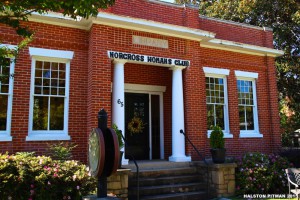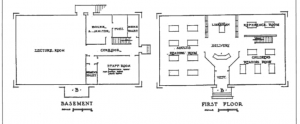By Geoff Hammett | It’s interesting that a Carnegie Library style building in Norcross resembles the early 1900s one-room Carnegie Library designs, but the Norcross library was built in 1921. So I investigated the possibility that the Norcross Library could be an unaccounted for Carnegie Library. Even if not funded as a Carnegie Library, the building is at least in spirit and in appearance a Carnegie Library. It eventually became the first library in Gwinnett County.
A Carnegie Library building grant to the Norcross Woman’s Club is described in the Allen Francis book Norcross (reprinted in the green Adams/Crapo Norcross book).
(Editor’s Note: A Gwinnettian has done research on a building approaching 100 years old…now called the Norcross Woman’s Club on North Peachtree Street. –eeb)
The book mentions that after much correspondence with Andrew Carnegie’s secretary, a grant of $5,000 was offered, but never secured, because the recipients felt the terms were too onerous. Carnegie Library funding generally required recipients to commit to raising 10 percent of the grant per year to maintain the library and provide free access to books.
The Norcross Woman’s Club initiated their library activity in response to the club’s State Federation request in 1907 to observe “Library Day.” Club members collected donations for a permanent library in Norcross including $2,500 from Edward F. Buchanan, an orphan boy raised in Norcross, who had exceptional skills in telegraphy and had become successful on Wall Street. However, Mr. Buchanan’s financial problems in 1908, and the subsequent return of his donation, in the form a loan to be paid back to the Woman’s Club with interest, held up the project.
Ten years later the loan was paid off by Mr. Buchanan’s adoptive mother’s estate yielding almost $5,000, but the encumbrance placed on the initial donation delayed the building completion until 1921.
In the book written by Abigail A. Van Slyck book, Free to All: Carnegie Libraries and American Culture, 1890-1920, the responsibility for library designs went to James Bertram, Andrew Carnegie’s personal secretary. From 1903 to 1911 Bertram reviewed every set of plans for Carnegie-financed libraries.
In 1911 Bertram documented guidance on library design in a pamphlet that included designs and floor plans. Reprinted in the book written by Theodore Jones, Carnegie Libraries Across America: a public legacy, all the floor plans in Bertram’s design guide depict one-story buildings with partially exposed basements and large windows. Each plan features a course of steps leading up to the main floor to remind entrants they are ascending steps toward knowledge. Here (attached) is the type “B” floor plan shown in the pamphlet, which presents an architectural design very consistent with the Norcross Library building.
Regarding other good references, here is a link to a summary of the Carnegie Libraries located in Georgia. Several of these Georgia buildings are listed on the National Register of Historic Places:
The Carnegie Corporation of New York may provide preservation funding, their website is www.carnegie.org. The Carnegie Correspondence Archives are located at Columbia University Rare Book and Manuscript Library. The curator of these archives would likely be interested in any Carnegie or Bertram correspondence from the Norcross Woman’s Club records, should anyone have it.














Follow Us